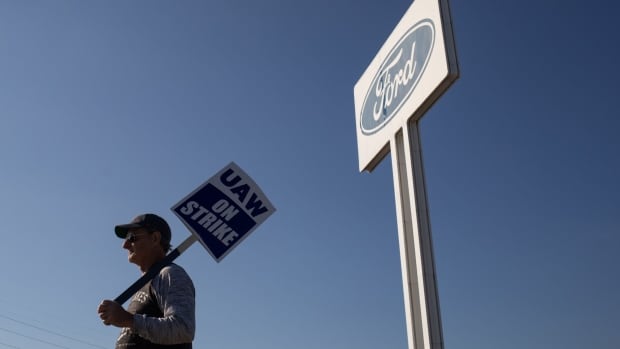A strike by thousands of U.S. autoworkers that started Friday will have limited impact on Canada’s industry at first, but it has the potential to bring the sector to its knees if it stretches into next week or beyond, analysts say.
About 13,000 members of the United Auto Workers walked off the job on Friday morning, picketing a General Motors assembly plant in Wentzville, Mo.; a Ford factory in Wayne, Mich., near Detroit; and a Stellantis Jeep plant in Toledo, Ohio.
It’s the first simultaneous job action at the three biggest U.S. automakers in the union’s 88-year history, after negotiations on working hours, job tiers, pensions and salaries have shown no progress after several weeks of talks.
Sam Fiorani, vice-president of global forecasting at AutoForecast Solutions, said the three locations chosen for the initial job actions were done strategically. They all make mid-size SUVs, which is an important segment for the automakers, but one in which they have excess inventory so consumers won’t feel it as much as the message sent to the companies will be.
“This is just a shot over the bow,” Fiorani told CBC News. “This is just the union saying we can bring down the whole company if we want to.”
If the union expands its strike action, nearly 150,000 workers could be involved and dozens of facilities scattered between New York and Texas could be shut down.
“There’s a minimal effect at the moment, but it is flexing muscles,” Fiorani said.
The two sides are far apart on just about every issue, with the union demanding wage increases of almost 40 per cent and the implementation of a four-day work week. The companies, meanwhile, have countered with wage hikes of roughly 20 per cent.
The best-case scenario, Fiorani said, is that the two sides meet in the middle “at about a 25 to 28 per cent raise and the strike is ended within the next week.”
But a worst-case scenario is very much in play, one where the strike stretches into next month or beyond, and the entire industry in the U.S — and Canada — grinds to a halt.
Featured VideoThe union representing nearly 150,000 autoworkers is on strike against GM, Stellantis and Ford. Andrew Chang breaks down the impact of using rotating strikes and what the UAW is asking for from the automakers.
Limited impact so far
The impact on Canada is muted thus far because no Canadian facilities provide many components to any of the affected facilities.
But Flavio Volpe, the head of the Automotive Parts Manufacturers’ Association, said that could change in a hurry.
“So far it’s a one-day strike, since there’s no production on the weekend,” he told CBC News in an interview. “But if we’re still talking about it on Monday and Tuesday — we’re a just-in-time industry, so we’re looking probably at shutting down production on the Canadian side.”
The impact long-term would be measured in billions of dollars. Canadian car parts makers like Linamar, Magna and dozens of others export $35 billion worth of goods every year, about half of which goes to GM, Ford and Stellantis factories in the U.S. and Mexico, Volpe said.
“We’ve been in a wrestling match with global dynamics for three years,” he said. “It’s going to have an impact if it goes on, on price and availability of new vehicles.”
Featured VideoU.S. President Joe Biden says he wants to see record corporate profits for automakers translate into ‘record contracts’ for members of the United Auto Workers union, which has thousands of members out on strike.
U.S. President Joe Biden weighed in on the strike on Friday, telling reporters that he wants to see the companies strike a fair deal for workers at a time when the industry is seeing record profits.
“No one wants to strike,” Biden said in brief remarks at the White House. “But I respect workers’ right to use their options under the collective bargaining system, and I understand the workers’ frustration.”
The U.S. strike comes as Canada’s biggest auto union, Unifor, is in the midst of negotiations of its own with the companies. The contract currently in place is set to expire next Tuesday, so theoretically a Canadian job action could start as early as then.
Unlike the UAW, which is negotiating with all three manufacturers at once, in Canada Unifor has chosen to target Ford first in the hopes of getting a deal it can then take to the others.
But Fiorani said things are different this time because there is an unprecedented amount of solidarity between the unions in Canada and the U.S.

“We’re in uncharted territory because the UAW and Unifor have never worked together on the same contract. Unifor has already said that they’re going to work with the UAW to make sure that everybody gets a fair shake so we’re expecting that if this contract is not signed in the next week, then Unifor will also strike.”
David Cassidy, president of Unifor Local 444, which represents workers at the Ford assembly plant in Windsor, Ont., said the U.S. situation is likely to overshadow Canadian negotiations in the short term.
“Now that they’re on strike, I think it might put a little bit of a halt on us and it might punt them days down the road,” he told CBC News in an interview. “We have to wait to see what deal comes in over there.”








